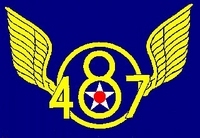 Rammed Over Germany
Rammed Over Germany
By W. Budd Wentz, MD, CAPT USAAF
with Tom McCrary
Mission Briefing (7 APR 45)
It was my 28th mission for the 838th squadron but the third and last emergency landing my crew and I would fly in combat. Our combat missions would soon be over. The 487th BG (H) had flown a total of 173 missions since May 1944 and would fly only 10 more missions by VE day May 8, 1945.
Saturday, April 7th 1945 started early like any other mission day, except today was my wife Bette’s birthday. Nothing was normal, but the routine was well entrenched and rehearsed. Twenty-seven missions earlier our crew’s first mission ended after we lost all four engines due to flak and I landed (#43-38033) in a pasture in southeast Belgium behind enemy lines. After a tense encounter with local citizens, the local Belgian resistance group around Rienne arranged for us to hide in their homes for 4 days until American Troops entered the village. We were taken to a convent to stay for several days until we were flown back to England in an RAF C-47.
Today the European Theater Of Operations for mission #931 of the Eighth Air Force reported “1,314 bombers and 898 fighters are dispatched to hit airfields, oil and munitions depots and explosive plants in C and N Germany; all primary targets are bombed visually; they met 100+ conventional fighters and 50+ jets; the German fighters attack fiercely and in the ensuing air battle down 15 heavy bombers; the AAF claims 104-13-32 aircraft including a few jets: 529 B-17s are sent to hit airfields at Kaltenkirchen (143) and Parchim (134), an oil depot at Buchen (36) and a munitions depot at Gustrow (104); secondary targets hit are the marshalling yards at Neumunster (37) and Schwerin (48); 1 other hit Salzwedel Airfield, a target of opportunity; they claim 26-10-10 aircraft; 14 B-17s are lost and 117 damaged;”
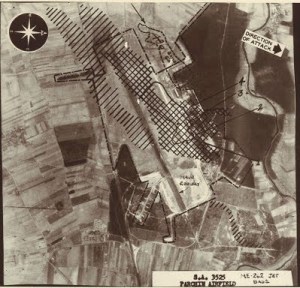
[NOTE: The 486th Bomb Group Association indicates that the 486th BG (H) dropped incendiaries on the Me-262 jet base over Parchim, GR at 1357 LST, 7 April 1945.]
Following the usual briefing we took off from Lavenham, England (station 137) flying the B-17G-105-BO (#43-39126) assigned to us in March in position #4 under the Group Leader’s plane to bomb a ME-262 jet airfield at Parchim, Germany. Just to my left rear in position #6 flew Brudsey, my best friend since Flight School.
The 838th Squadron was leading that day. The weather was excellent with only a few puffy clouds at about 20,000 feet. At approximately 13:10 hrs, I took the controls from the co-pilot while continuing to monitor the Group radio channel. The talk was relatively quiet with no calls announcing any German fighters or flak at that time.
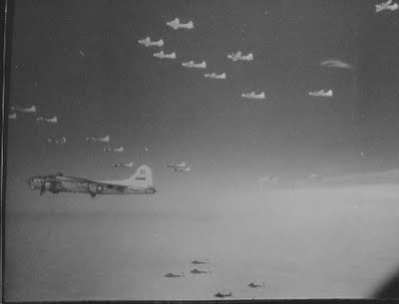
Impact
Suddenly, while on route to the IP (Initial Point), we received a terrific jolt and bang. I tightened up on the wheel to prevent it from swerving. The waist gunner reported over the intercom that our plane had been hit in the tail by an ME-109 diving down from 4 o’clock high.

The tail gunner, Sgt. Jewell, was shoved forward 4-5 feet, but was only banged around. The plane was functioning okay so I held position for a few moments. The crew reported pieces of the tail and rudder were falling off. Our Navigator, Boyer, reported we were over Donitz. The engineer in the top turret reported he could see that the vertical stabilizer was severely damaged. From the left side of the plane the crew observed that an ME-109 had severely damaged its right wing and was spinning down out of control. No parachute was seen while the crew could see the ME-109.
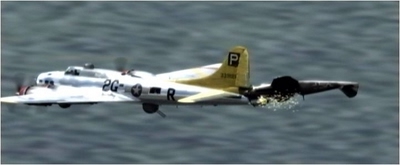
Not wanting to damage any other planes, I increased speed and planned to dive forward out of the formation. Unfortunately the plane didn’t dive when I pushed the wheel forward. I flew ahead of the formation and then cut the throttles back and let down in a flat aspect. After leaving the formation, I found that kicking the rudder didn’t turn the plane either. We couldn’t climb, couldn’t dive or turn; it was apparent that I had no rudder or elevator control. Keeping the airplane level, I let down and turned by cutting the throttle on the outboard engine on that side and skidded around.
Emergency Landing
To prepare for emergency landing we dropped our bomb load in an open area then headed westerly while making a large circle to keep a flat attitude. The crew continued to report pieces falling off. I felt I had better get the plane on the ground quickly; but not to quickly. The navigator and bombardier found an airfield to the north with a single light gray runway. It could have been worn asphalt or concrete. Low trees and cut grass surrounded the area. I approached in a northern direction and lightly touched down. It had been about 20 minutes since we were hit. Strange that we hadn’t seen any other Luftwaffe fighters near our plane on the descent. We didn’t know if any other B-17s were hit.
On the right side of the runway, in the southeast quadrant, there were one or two small one story low buildings. Several new looking ME-262s were lined up under the trees. It was definitely a small facility in a very rural location without much fanfare.
We were in Germany and expected to be in a Stalagluft as POWs in short order. At least we were on the ground unharmed. I came to a stop and taxied toward a building. To my surprise American soldiers came running and driving out to the plane. “What the hell are you doing? You aren’t supposed to land here.”, shouted an American Army Major standing in his jeep. We learned that the Americans had just occupied the airfield only 2-3 hours earlier. In typical fashion I sarcastically told the Major what I thought of his demands and informed him of our predicament. He stormed off back to the buildings.
After exiting the plane and checking that the crew was unharmed, we inspected our plane and was shocked to see that the movable rudder was completely gone and the vertical stabilizer was pretty extensively damaged. The right horizontal stabilizer was reduced to less than one-third its size while the left and right elevators were completely gone. The tail of the fuselage was crushed including the tail turret while tip of a ME-109 wing was embedded in the fuselage. We pulled the tip of the ME-109 out and kept it as a souvenir.
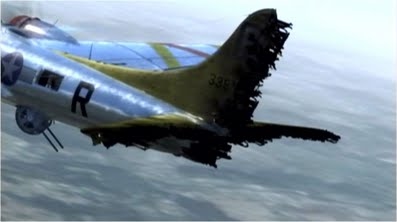
[NOTE: A piece of the ME-109 wing section is on display at the Eighth Air Force Museum in Savannah, Georgia. Two pieces of the B-17 wing fabric are on display at the MAPS Air Museum at the Akron-Canton Airport in Ohio.]
Commandeered Flight Home
Looking around we found a beat up B-17 under some trees at the edge of the runway. It was an old camouflaged plane with no markings and no chin turret, probably a B17-E or F. It was in rough shape, but nonetheless no FLAK holes. The plane was pretty beat up, but after inspecting we decided to fuel it up and attempt to fly it out. From a jeep generator we started the decrepit B-17 and ran up the engines. Not wanting to waste any more time, we taxied to the end of the runway and commenced to take-off.
We headed west back to our airbase in England by flying slow and low at 3 – 4,000 feet keeping watch for airfields along the way just in case we needed to land again quickly. By now it was late in the day and starting to get dark. We landed at our home airbase in Lavenham several hours after the group had returned. Somewhat reminiscent of our earlier landing that day another American officer came racing out to our plane, “What the hell happened to my new 17? You were supposed to be here hours ago.” I told the Major that we left his new plane back in Germany and traded it for this one instead.
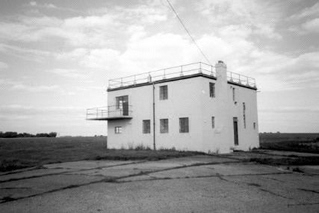
Mission Debrief
We were driven to the mess hall but were never officially debriefed or interrogated. Later that evening I was taken to the Group Commander, Col. William K. Martin, and gave him a short version of our events that day. He told me that we would not have to fly any further combat missions in the war, but he would not ground us. We had crash landed 2 times in 28 missions as well as returned 5 times on two engines. No doubt we were Lucky Bastards and our war was over.
Lucky Bastards Club (14 APR 45)
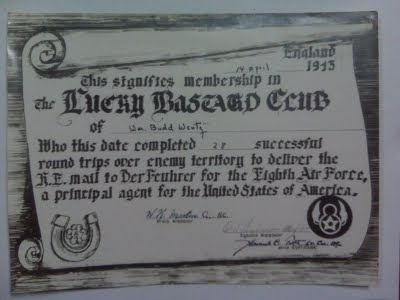
Discovery 60 Years Later
Rammkommando “ELBE”
Since 2003 I have corresponded with Dr. Fritz Marktscheffel, archivist of Schulungskommando (schulungeslehrgang) “ELBE” and Arno Rose, both members of an organization in Germany dedicated to the preservation and dissemination of accurate information regarding a little known group in the Luffwaffe called Rammflotte Elbe. Through numerous exchanges and research, their group deduced that the pilot of a BF109 who rammed our B-17 was Klaus Hahn and that I crash landed at Wernershohe. [Marktscheffel, Fritz, Dr., opapi@nexgo.de, Nachtigallenweg 8, D-61479 Glashütten/Ts.; Rose, Arno, onraesor@web.de]
See http://en.wikipedia.org/wiki/Sonderkommando_Elbe
Uffz Klauz Hahn took off in his Bf 109G, nicknamed “Beule”, from Sachau with his squadron, but lagged behind because of a mechanical problem in the early minutes of his flight. Arriving at a height of 10,000 meters (~32,000 feet) over the area east of Weser, Klaus ran into a swarm of P-51 Mustangs. He was shot at from the left and behind. His face was cut from splinters from the instrument panel, his left upper arm was broken by a bullet, and left hand was badly mangled.
In Klaus’ personal account he writes; “ I rolled my plane sideways and dived towards the bombers for an attack. On nearing the height on which they flew, I clearly identified them as B-17s. I did not dive straight at my target, but a little from the side. I pulled my machine out of the dive as steeply as I could and charged at the side of the bomber. With the high speed that I had built up in the power dive, I approached the bomber very rapidly. What actually happened during the actual ramming, I cannot tell from my own observations. My last thought was: ‘Get out now!’ and I must have acted accordingly. An eye witness on the ground later explained that my machine was trailing smoke immediately after combat with the Mustangs.”
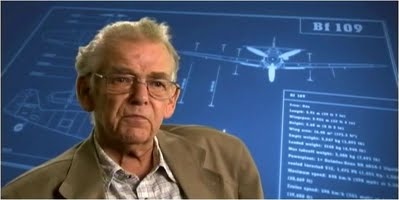 The Fortress that Klaus Hahn rammed was a B-17 of the 487th BG which was observed rammed from a four o’clock high position at 1315 hours in position 52° 40’N-09° 50’E, after which the wing of the Bf109 came off and the fighter exploded. Although damaged in the tail unit, the bomber started limping back to base.
The Fortress that Klaus Hahn rammed was a B-17 of the 487th BG which was observed rammed from a four o’clock high position at 1315 hours in position 52° 40’N-09° 50’E, after which the wing of the Bf109 came off and the fighter exploded. Although damaged in the tail unit, the bomber started limping back to base.
Klaus passed out several times while tumbling though the sky and then again when his parachute opened. Uffz Hahn was taken to a hospital at Munster-Lager, where both hip joints had twisted out of their sockets. They operated on his left arm, but had it had to be amputated a few weeks later due to a fever. [NOTE: Details from Klaus Hahn’s report can found in RAIDERS OF THE REICH by Martin W. Bowman and Theo Boiten, Airlife Publishing, ISBN 1 85310 746 8, Chapter 10 Fighter Finale, pg. 208.]
Two German TV-stations made a film of the last efforts of the German fighters, titled “Das Letze Aufgebot”. Fritz assisted the producer. Part of the film is a report by Klaus Hahn of his mission and his ramming action.
Wernershöhe
There was a secret unit within the German Air Force which took captured allied aircraft and adopted them for secret service flights (to France, the Netherlands, Spain, Great Britain, etc) transporting foreign spies and supplying resistance people to undermine enemy regimes. The first group of this unit, KG200, had B-17s and a B-24 at Hildesheim and Wernershöhe, 30km south of Hannover. Wernershöhe was surrounded by woods and was an auxiliary airstrip to the bigger airfield of Hildesheim. This is where they hid the B-17s with swastika’s on the tail.
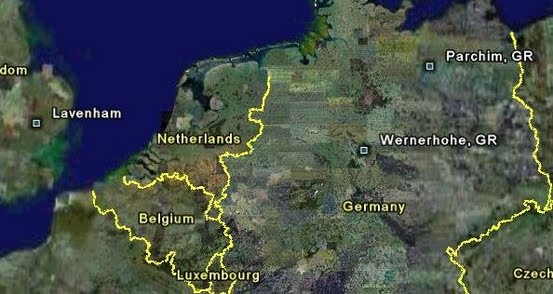 In 1945 the Luftwaffe airfield at Wernershöhe had a paved Northeast-Southwest runway, low buildings and some Me 262’s. It was a satellite field of the airbase Hildesheim. The Luftwaffe stored and repaired captured B-17s then painted them tan with swastika markings on the wings and rudders. On April 6th six or seven captured Bombers took off from Wernershöhe. On April 7th the airfield was captured by American troops. This was the place we landed and found the old B-17.
In 1945 the Luftwaffe airfield at Wernershöhe had a paved Northeast-Southwest runway, low buildings and some Me 262’s. It was a satellite field of the airbase Hildesheim. The Luftwaffe stored and repaired captured B-17s then painted them tan with swastika markings on the wings and rudders. On April 6th six or seven captured Bombers took off from Wernershöhe. On April 7th the airfield was captured by American troops. This was the place we landed and found the old B-17.
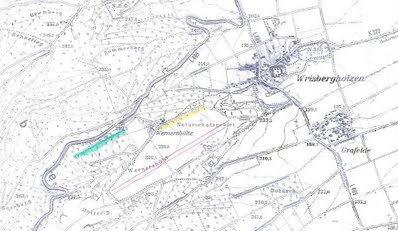
Red = 5400-6000 ft runway. Blue = Location of Me109 or Me109F
Kurt Madel (a member of the Flieger-HJ Alfield from 1945 to 1957) reports that on 7 April 1946, the city of Alfed and the village of Werrshohe had been peacefully occupied by the US 331 Infantry Regiment/83rd Infantry Division. On 9 April 1945 Kurt received orders from the Military Administration to carry out a courier service. During this time he visited the airfield at Wernershohe frequently. Kurt recalls seeing one damaged Ju 88 and several undamaged Bf 109 aircraft at the edge of the woods without any guard. The runway was rumply and one couldn’t see the end of the runway before takeoff.
Afterword
Kingman
We never found out what happened to the B-17 we commandeered from Germany and flew back to England. Much later we learned that our new B-17G #43-39126 was repaired and returned to the USA by boat and finally sent to Storage Depot No. 41 in Kingman, Arizona. B-17s were collected at Kingman AAF Depot 41 in Arizona where they waited to be cut up by the salver’s knife. 5,748 warbirds were eventually sold as surplus, or melted down into ingots.

Photo from the Smithsonian, December 1995, Volume 26, Number 9, page 58-59
Conflicting Records
Many published accounts of this incident are not true and quite inaccurate. Adrian Weir correctly writes in his book; “At least 2 reports from the 3rd Air Division mention the attack upon the 487th Bomb Group on April 7th. The reports say the attack was by a single Bf109 at approximately 13:10, (position reference 5225-0910).”
Weir incorrectly wrote, ”Damage was reported to aircraft in positions 5, 4 & 2 of the leading Squadron. The gunnery report says that the nose-gunner of aircraft 6 caused damage to the Bf109 causing it to crash into the tail of the bomber in position 7. This was the B-17 39126 of Budd Wentz.”.
I believe the author was confused and incorrectly put two separate incidents together. It is interesting that at that time and since then the air force has never reported these incidents as planned ramming attacks, but stated once as some “fanatical actions”.
Navigation Calculations
Parchim,GR (53:25:37N 11:47:00E)
Latitude 53.43333 Lat (DMS) 53d 26m 0s
Longitude 11.85000 Long (DMS) 11d 51m 0s
Wernershöhe,GR (52:03:00N 9:55:00E)
Latitude 52.0500 Lat (DMS) 52° 2′ 60N
Longitude 9.9167 Long (DMS) 9° 55′ 0E
Altitude (feet) 541 Altitude (meters) 164
Straight line distance from Wernershöhe,GR to Parchim,GR is 125 miles.
Straight line distance from Wernershöhe,GR to Lavenham,UK is 388 miles.
Analysis of the time frame, distance, speed, and relative descriptions shows the following route may have been taken to the Wernershohe,GR.
1. Last turning point to Dömitz: 63 km, heading 360°
2. Turning point before last one (~5 km SSO Klötze) to last turning point: 129 km, approx. 270°.
3. Next turning point approx 10 km SSO of Nienburg
4. Further heading approx. 228/230 ° to the area od Oelde /Aalen.
History of B-17 #43-39126
Boeing C/n: #10104
Boeing Type: B-17G-105-BO
Boeing Line: xxx
104th plane produced at Boeing Seattle (Part 06)”. Data from “Boeing Production List.
1944/12/08 43-39126 Del Hunter
1944/12/21 Dow Fd 21/12/44
1945/03/07 Assigned 838 BS / 487 BG Lavenham
1945/07/13 ret. US Bradley
1945/07/15 4185 BU Independence
1946/01/03 RFC Kingman AAFld
Source: “The B-17Flying Fortress Story”, by Roger Freeman
Source: http://home.att.net/~jbaugher/1943_2.html
The AFHRA 520.83A, Eighth AF, Monthly Reports of Eighth AF Aircraft Salvaged on the Continent for April, May, and June contain no entry for B-17G s/n 43-39126.
39126 (487th BG, 838th BS) tail was rammed by Uffz Klauz Hahn in Bf 109G of Skdo. Elbe but landed safely on freshly-captured Me 262 airstrip near Wernershohe, Germany Apr 7, 1945. Both the B-17 crew and the Bf 109 pilot survived. Plane was repaired and returned to USA, where it was scrapped at Kingman, AZ. MACR 11732.
Report on A/C Abandoned on Continent (7 APR 45)
1. MISSION: PARCHIM, 7 APR 45 2. A/C 43-39126, LT WILLIAM B WENTZ, PILOT. 3. A/C RECEIVED MAJOR DAMAGE IN COLLISION WITH E/A. LANDED AT A-92. ¾ OF LEFT HORIZONTAL STABILIZER SHEARED OFF, AND ONLY ONE FOOT OF ELEVATOR SURFACE REMAINED. TAIL TURRET SMASHED. 4. ALL CREW MEMBERS RETURNED TO BASE. S/SGT ROBERT C. JEWELL, 36895035, TAIL GUNNER, WAS WOUNDED SLIGHTLY. T/ST JEROME H CARSON, 36727881, RADIO OPERATOR, RECEIVED CUT ON HAND IN COLLISION WITH E/A. 5. CREW FERRIED AN A/C TO B-53 AND THEN FERRIED ANOTHER A/C TO HONINGTON. TREATMENT ON CONTINENT NOT VERY GOOD. POOR FACILITIES.
Crew Interrogation Form (7 APR 45)
PILOT: WENTZ, W.B. DATE: 7 APRIL 1945 A/C#: 126 SQ: 838 TARGET ATTACKED BY THIS A/C: TGT OF OPPORTUNITY IN GERMANY TERRITORY TIME OF TAKE OFF: 0920 TIME OF LANDING: 1445 AT A-92 POSITION IN FORMATION AT ASSEMBLY: #7 LEAD POSITION IN FORMATION OVER TARGET: LEFT FORMATION BEFORE TGT. IF A/C TURNED BACK: TIME OF TURN BACK: 1212 PLACE: 52°33' - 09°28' ALTITUDE: 14,800' REASON: PLANE STRUCK BY ENEMY. FIGHTER (ME109) DAMAGING TAIL ASSEMBLY. IF BOMBS JETTISONED GIVE: TIME: 1314 PLACE: 52°30', 9°35' ALT: 14,500’ REASON: A/E DAMAGED AND NEEDED TO REDUCE WT. BOMB LOAD: 38-100#GP BOMB # ON TARGET: 38 BOMB RETURNED: 0 BOMB TIME: 1314 BOMB HEADING: 180° BOMB ALTITUDE: 14800' BOMB RESULTS: NOT OBSERVED BATTLE DAMAGE: MAJOR BY E/A
Report on Returning from the Continent (8 APR 45)
Click image below

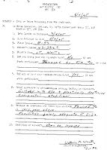
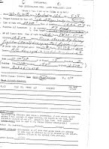
November 3, 2020 at 6:06 am
Budd Wentz was a professor of mine at CWRU medical school… great physician. I lost all my rudder and elevator control in small experimental aircraft, years ago. I can relate.
CWRU class 1978
LikeLike